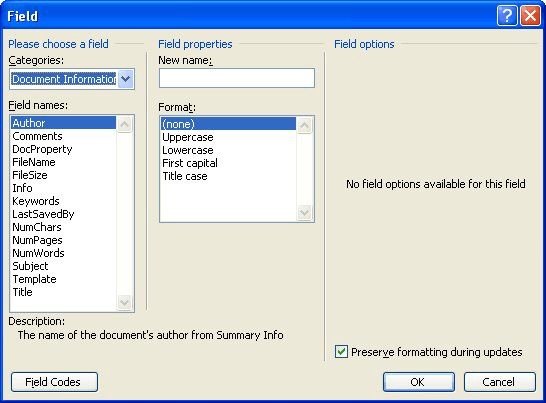Please Note: This article is written for users of the following Microsoft Word versions: 97, 2000, 2002, and 2003. If you are using a later version (Word 2007 or later), this tip may not work for you. For a version of this tip written specifically for later versions of Word, click here: Using the INFO Field.
Written by Allen Wyatt (last updated August 1, 2020)
This tip applies to Word 97, 2000, 2002, and 2003
Word maintains a wide variety of information in relation to a document. Most of this information you can see by clicking on the Properties option from the File menu.
Word also provides many different fields that allow you to insert this "maintained information" in your document. For instance, you can use the FILESIZE field to insert the size of your document file, in bytes.
Besides individual fields to insert document information, Word also provides the INFO field that can insert much of the same information. To see what information you can use it to insert, follow these steps if you are using Word 2002 or Word 2003:

Figure 1. The Field dialog box
If you are using Word 97 or Word 2000, follow these steps:
Regardless of which version of Word you are using, notice the wide variety of information you can use the INFO field to insert. Why, however, would you use the INFO field in preference to a different field that could insert the same information?
The answer is that in most cases you wouldn't; the INFO field simply serves as an alternate way of accomplishing the same task. There is one instance where you will find the INFO field indispensable, however. The field allows you to update the contents of some document properties, right within the field. If you use the INFO field with certain info types, you can add another argument to your field and Word will update the property. A simple example is the following:
{ INFO Comments "These are mine" }
This field results in the Comments document property being updated to "These are mine." You can use the INFO field to update any of the following document properties (info types): Author, Comments, Keywords, Subject, and Title.
WordTips is your source for cost-effective Microsoft Word training. (Microsoft Word is the most popular word processing software in the world.) This tip (552) applies to Microsoft Word 97, 2000, 2002, and 2003. You can find a version of this tip for the ribbon interface of Word (Word 2007 and later) here: Using the INFO Field.

Create Custom Apps with VBA! Discover how to extend the capabilities of Office 2013 (Word, Excel, PowerPoint, Outlook, and Access) with VBA programming, using it for writing macros, automating Office applications, and creating custom applications. Check out Mastering VBA for Office 2013 today!
Got a bunch of info that is common to a lot of your documents? Here's a way to get that information standardized among ...
Discover MoreWord provides a handy shortcut that allows you to update the fields in any text you've selected. When you select your ...
Discover MoreWord keeps track of many statistics for each of your documents. One statistic is the total number of pages in the printed ...
Discover MoreFREE SERVICE: Get tips like this every week in WordTips, a free productivity newsletter. Enter your address and click "Subscribe."
There are currently no comments for this tip. (Be the first to leave your comment—just use the simple form above!)
Got a version of Word that uses the menu interface (Word 97, Word 2000, Word 2002, or Word 2003)? This site is for you! If you use a later version of Word, visit our WordTips site focusing on the ribbon interface.
Visit the WordTips channel on YouTube
FREE SERVICE: Get tips like this every week in WordTips, a free productivity newsletter. Enter your address and click "Subscribe."
Copyright © 2024 Sharon Parq Associates, Inc.
Comments